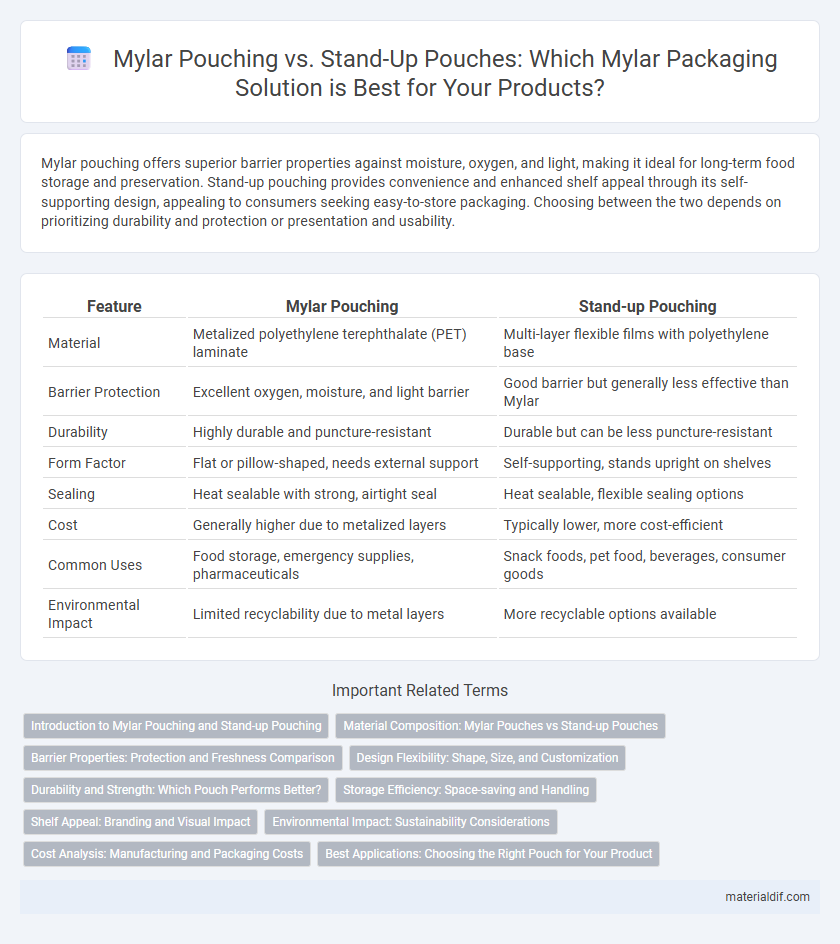Mylar pouching offers superior barrier properties against moisture, oxygen, and light, making it ideal for long-term food storage and preservation. Stand-up pouching provides convenience and enhanced shelf appeal through its self-supporting design, appealing to consumers seeking easy-to-store packaging. Choosing between the two depends on prioritizing durability and protection or presentation and usability.
Table of Comparison
| Feature | Mylar Pouching | Stand-up Pouching |
|---|---|---|
| Material | Metalized polyethylene terephthalate (PET) laminate | Multi-layer flexible films with polyethylene base |
| Barrier Protection | Excellent oxygen, moisture, and light barrier | Good barrier but generally less effective than Mylar |
| Durability | Highly durable and puncture-resistant | Durable but can be less puncture-resistant |
| Form Factor | Flat or pillow-shaped, needs external support | Self-supporting, stands upright on shelves |
| Sealing | Heat sealable with strong, airtight seal | Heat sealable, flexible sealing options |
| Cost | Generally higher due to metalized layers | Typically lower, more cost-efficient |
| Common Uses | Food storage, emergency supplies, pharmaceuticals | Snack foods, pet food, beverages, consumer goods |
| Environmental Impact | Limited recyclability due to metal layers | More recyclable options available |
Introduction to Mylar Pouching and Stand-up Pouching
Mylar pouching involves sealing products in polyester film bags known for their exceptional barrier properties against moisture, oxygen, and light, ensuring extended shelf life for perishable goods. Stand-up pouching, a versatile packaging solution, features a bottom gusset that allows the pouch to remain upright on shelves, enhancing product visibility and consumer convenience. Both Mylar and stand-up pouches utilize durable, multi-layered materials designed to protect contents while offering flexibility in size and design for various industries.
Material Composition: Mylar Pouches vs Stand-up Pouches
Mylar pouches are typically made from a laminated film composed of polyethylene terephthalate (PET), aluminum foil, and polyethylene, offering superior barrier properties against moisture, oxygen, and light. Stand-up pouches often use multi-layered polyethylene or polypropylene films that provide flexibility and durability but may lack the enhanced protection of Mylar's aluminum layer. The material composition of Mylar pouches makes them ideal for long-term preservation, whereas stand-up pouches prioritize cost-effectiveness and resealability.
Barrier Properties: Protection and Freshness Comparison
Mylar pouching offers superior barrier properties with enhanced protection against moisture, oxygen, and light, preserving product freshness for extended periods. Stand-up pouches provide moderate barrier protection but often require additional laminates or coatings to reach the same level of preservation as Mylar. The high impermeability of Mylar films makes them ideal for sensitive products needing long-term shelf stability and freshness retention.
Design Flexibility: Shape, Size, and Customization
Mylar pouching offers extensive design flexibility with customizable shapes and sizes tailored to product specifications, enabling secure, airtight packaging ideal for long-term preservation. Stand-up pouching emphasizes stability and display appeal with a flat base, supporting various sizes while enhancing shelf presence and consumer convenience. Both methods allow high customization in printing and features such as resealable zippers, but Mylar's versatility excels in complex barrier properties and unique form factors.
Durability and Strength: Which Pouch Performs Better?
Mylar pouches feature superior durability and strength due to their multi-layered polyester film construction, providing excellent resistance to punctures, moisture, and oxygen. Stand-up pouches, often made with similar materials but designed for convenience and display, may sacrifice some structural integrity for flexibility and reusability. For applications demanding maximum protection and shelf life, Mylar pouches outperform stand-up pouches by maintaining product freshness and resisting external damage more effectively.
Storage Efficiency: Space-saving and Handling
Mylar pouching offers superior storage efficiency compared to stand-up pouching due to its flat, flexible design, which allows for denser stacking and reduced warehouse space consumption. Its lightweight and collapsible nature simplify handling and transportation, leading to lower shipping costs and easier inventory management. In contrast, stand-up pouches require more vertical space and are less adaptable to compact storage solutions.
Shelf Appeal: Branding and Visual Impact
Mylar pouches offer a sleek, reflective surface that enhances shelf appeal by making branding elements pop with vibrant colors and sharp logos. Stand-up pouches provide a dynamic, stable display area that maximizes visibility and allows for innovative designs, capturing consumer attention at eye level. Both packaging types boost visual impact, but stand-up pouches typically offer greater customization options for branding, reinforcing product identity and shelf differentiation.
Environmental Impact: Sustainability Considerations
Mylar pouching typically involves multi-layered polyester films combined with aluminum, making recycling challenging due to material separation issues. Stand-up pouches often incorporate recyclable polyethylene or biodegradable films, enhancing their sustainability profile by reducing landfill waste. Choosing stand-up pouches can significantly lower environmental impact by supporting circular economy practices and minimizing carbon footprint in packaging.
Cost Analysis: Manufacturing and Packaging Costs
Mylar pouching typically incurs higher manufacturing costs due to the material's durability and barrier properties, which require advanced equipment and longer production times. Stand-up pouching often offers cost advantages in packaging because of its efficient space utilization and lighter materials, reducing shipping and storage expenses. Evaluating total expenses reveals that while Mylar pouches excel in product protection, stand-up pouches often provide better cost-efficiency in large-scale packaging operations.
Best Applications: Choosing the Right Pouch for Your Product
Mylar pouches excel in applications requiring high barrier protection against moisture, oxygen, and light, making them ideal for preserving food freshness and pharmaceuticals. Stand-up pouches offer superior shelf appeal and ease of use, suited for retail products like snacks and pet food where visibility and convenience drive consumer choice. Selecting between Mylar and stand-up pouches depends on product sensitivity, market presentation, and storage longevity needs.
Mylar Pouching vs Stand-up Pouching Infographic

 materialdif.com
materialdif.com